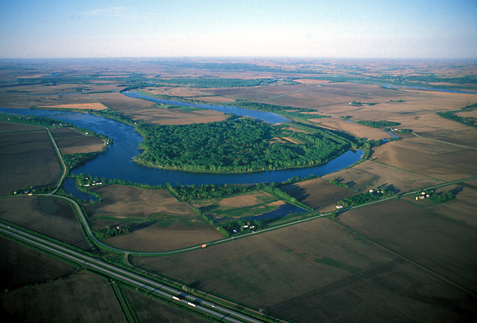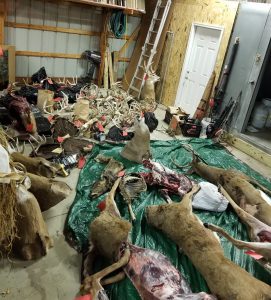CLICK HERE for the latest market quotes from the Iowa Agribusiness Network!
CLICK HERE for the latest market quotes from the Brownfield Ag News Network!
CLICK HERE for the latest market quotes from the Iowa Agribusiness Network!
CLICK HERE for the latest market quotes from the Brownfield Ag News Network!
DES MOINES, Iowa, March 30, 2022 – The U.S. Department of Agriculture (USDA) encourages producers and landowners to enroll in the Grassland Conservation Reserve Program (CRP) starting next week through May 13, 2022. Grassland CRP provides a unique opportunity for farmers, ranchers, and agricultural landowners to keep land in agricultural production and supplement their income while improving their soils and permanent grass cover. The program had its highest enrollment in history in 2021 and is part of the Biden-Harris Administration’s broader effort to equip producers with the tools they need to help address climate change and invest in the long-term health of our natural resources.
Grassland CRP is a federally funded voluntary working lands program. Through the program, USDA’s Farm Service Agency (FSA) provides annual rental payments to landowners to maintain and conserve grasslands while allowing producers to graze, hay, and produce seed on that land. Maintaining the existing permanent cover provides several benefits, including reducing erosion, providing wildlife habitat and migration corridors, and capturing and maintaining carbon in the soil and cover.
“Grassland CRP is an important working lands conservation tool that offers a win-win to both our country’s producers and the environment by supporting and enabling grazing activities, while at the same time promoting plant and animal biodiversity and stemming rangeland conversion,” Matt Russell, FSA State Executive Director in Iowa. “We had a successful signup last year, and we look forward to broadening our base and working with new producers, particularly our historically underserved producers, to ensure they can access the program and its many benefits.”
FSA provides participants with annual rental payments and cost-share assistance. The annual rental rate varies by county with a national minimum rental rate of $13 per acre for this signup. Contract duration is 10 or 15 years.
Broadening Reach of Program
As part of the Agency’s Justice40 efforts, producers and landowners who are historically underserved, including beginning farmers and military veterans, will receive 10 additional ranking points to enhance their offers. Additionally, USDA is working to broaden the scope and reach of Grassland CRP by leveraging the Conservation Reserve Enhancement Program (CREP) to engage historically underserved communities. CREP is a partnership program that enables states, Tribal governments, non-profit, and private entities to partner with FSA to implement CRP practices and address high priority conservation and environmental objectives. Interested entities are encouraged to contact FSA.
More Information on CRP
Landowners and producers interested in Grassland CRP should contact their local USDA Service Center to learn more or to apply for the program before the May 13 deadline. Additionally, fact sheets and other resources are available at fsa.usda.gov/crp.
DES MOINES, Iowa (March 30, 2022) – The Iowa Department of Agriculture and Land Stewardship and the United States Department of Agriculture (USDA) Animal and Plant Health Inspection Service (APHIS) have confirmed a positive case of highly pathogenic avian influenza (HPAI) in Buena Vista County, Iowa. The virus was found in a commercial turkey flock. This is the fourth confirmed case of HPAI in Buena Vista County.
Flock owners should prevent contact between their birds and wild birds and report sick birds or unusual deaths to state/federal officials. Biosecurity resources and best practices are available at iowaagriculture.gov/biosecurity. If producers suspect signs of HPAI in their flocks, they should contact their veterinarian immediately. Possible cases should also be reported to the Iowa Department of Agriculture and Land Stewardship at (515) 281-5305.
According to the U.S. Centers for Disease Control and Prevention, the recent HPAI detections in birds do not present an immediate public health concern. No human cases of these avian influenza viruses have been detected in the United States. It remains safe to eat poultry products. As a reminder, the proper handling and cooking of poultry and eggs to an internal temperature of 165 ˚F kills bacteria and viruses.
(Audubon, Iowa) – Landus, Iowa’s largest farmer-owned cooperative, and AMVC, the ninth-largest pork producer in the United States, today announced collaborative plans to build a new feed mill at the existing Landus grain facility located in Hamlin (Iowa). Officials say through this partnership, AMVC will own and operate the feed mill. Landus will be responsible for originating grain for the project through its network of local farmer-owners.
Matt Carstens, President and CEO of Landus, says “We are proud to demonstrate the power of partnership as we introduce this collaborative model to the local feed landscape. By working together from the start, Landus and AMVC have developed an optimized approach that allows each party to focus on its strengths while better meeting the unique needs of our differing stakeholders. This improved model gives AMVC better control of their long-term biosecurity and traceability requirements, while Landus can focus on sourcing and delivering quality grain from our farmer-owners. By working together, we can both responsibly invest where it makes the most sense; for Landus that means using farmer-owner money in the most effective way possible.”
The proposed feed mill will produce up to 400,000 tons of swine feed per year. It will generate demand for roughly 8.5 million bushels of corn, and 48,000 tons of soybean meal annually. Corn demand will exceed the capacity of the existing Landus grain storage in Hamlin, allowing Landus the opportunity to leverage its nearby grain assets, including a site in Panora, Iowa, which was recently acquired through an asset swap with Heartland Co-op, to supply corn to the new mill.
Dr. Steve Schmitz, veterinarian and managing partner at AMVC, said “AMVC is excited to align with Landus, a like-minded agriculture organization committed to enhancing our rural economies. Landus will provide AMVC the expertise to source and deliver quality grain from local farmers, allowing us to better leverage our strengths of professionally raising and feeding pigs. The establishment of this feed mill will maintain and increase long-term agriculture value for crop producers and pork producer stakeholders within Audubon County. This partnership also adds to the overall economic growth of the community by creating short and long-term employment opportunities. For over 30 years, AMVC has been committed to investing in livestock production and animal wellbeing. This investment furthers our pursuit to feed the world through our local communities.”
Once fully operational, the mill will employ up to eight full-time personnel and generate demand for an additional 14 local truck drivers. AMVC currently anticipates project completion by Summer 2024. Additional updates will be provided to the public as this project progresses.
(Radio Iowa) – Opponents of proposed carbon pipelines have staged what they’re calling a public hearing in the Iowa Capitol rotunda. Shelby County Supervisor Steve Kenkle says there’s been little public input and county officials lack the authority to have any say about the projects. “I call a spade a spade and if it doesn’t make sense or people are not accountable, I ask a lot of questions and so I’ve been at meetings asking questions…I think the process is flawed,” Kenkel said to applause and cheers. “It’s flawed and that’s the reason I’m here.”
Kenkel lives on a century farm near Earling, about a mile from the proposed route for the Summit pipeline. Some of the other speakers were landowners who don’t want to sell easements on their property so the pipelines can pass through. They oppose letting the Iowa Utilities Board invoke eminent domain authority so property can be seized for the projects. Carolyn Raffensperger, executive director of the Science and Environmental Health Network, also addressed the crowd.
“They want to take your property through this unique power of government and hand it over to a private corporation so they that they make their profit using your land…and I say: ‘No!'” Raffensperger said, to cheers. A small group of union members attended the rally with the counter message that good-paying jobs are connected to pipeline construction.
(Radio Iowa) – Two more commercial bird flocks have been confirmed with the avian flu. Iowa Ag Secretary Mike Naig announced today (Tuesday) that a Guthrie County layer facility with one-point-five million birds and a Hamilton County turkey facility with 28-thousand birds are infected. “We are now at nine cases total in the state of Iowa, two backyard flocks, seven commercial operations,” Naig says.
Naig says this year’s outbreak is a little different than the major one in 2015. “What’s notable about what is happening this year is there is a strong indication that the virus is being carried in the wild bird population. That what we are seeing largely across the entire country — starting on the East Coast and now moving into the Midwest — is that these are independent wild bird introductions into these operations,” according to Naig.
Naig says it does not appear there is any facility to facility spread now and they want to keep it that way. He says it remains important for producers to closely monitor the animals and report any signs of the disease immediately. Information on the disease is available at IowaAgriculture.gov. State Veterinarian Jeff Kaisand says protocol requires the birds to be destroyed within 24 hours once the bird flu has been detected.
He says they start talking with producers about what typ of depopulation method they want to use at the first signs that they may have an infection and then work with them to carry it through. Kaisan says they so far have been able to meet the 24-hour timeline. “They’re doing it on-site and we are not moving anything bird wise from an infected site,” he says. Kaisand says they are monitoring the wild bird migration as part of their efforts.
“There’s some days when there’s a lot of movement and when it gets cold there is a little bit of stall out. And some days there’s movement in different directions. We are all hopeful that it moves through quickly and we get to warmer weather. But it all depends on the weather and how quickly they move,” Kaisand says. More than seven million birds have now been impacted.
(Atlantic, Iowa) – Atlantic Parks and Recreation Dept. Director Bryant Rasmussen says, if you’re “Looking for an opportunity to give back to the community? There is a work day out at Sunnyside Park on Saturday April 2nd from 1-3 pm.”
Rasmussen said also, ” We are gearing up for a busy summer season and appreciate all the help we can get.” If you have any questions, please give him a call at 712-243-3542, or e-mail brasmussen@cityofatlantic.com

Flyer created by an Atlantic High School student.
(Onawa, Iowa) – Officials with the Iowa Department of Natural Resources (DNR) will host a public meeting at 6 p.m., March 31, at the Lewis and Clark State Park’s Visitors Center to discuss ongoing lake restoration efforts at the park, including a hydraulic dredging project slated for the 2022 open water season. Restoration activities planned for the park will be presented at the meeting, along with an opportunity for the public to ask questions about the dredging operations and potential impacts to the park throughout the construction season.
Over the past decade, members of the community have worked with DNR and other project partners to develop and implement a comprehensive lake restoration plan to improve water quality and recreational opportunities at Blue Lake. Hydraulic dredging is a significant step in the restoration process for improving water quality in the lake.

Blue Lake, Onawa, Iowa (Via Lewis-Clark.org)
The dredging project at Blue Lake wildlife area is being completed in two phases: phase one, completed in 2021, constructed a sediment containment site for holding dredge materials from the lake, and phase two will hydraulically remove approximately 434,000 cubic yards of sediment from the main basin of the lake to minimize sediment resuspension and improve water clarity. For more information about the Blue Lake Restoration project, check out the video on YouTube: https://www.youtube.com/watch?v=NAlqglIxTBU
Blue Lake was added to the State’s list of Impaired Waters in 2004 due to poor water transparency attributed to sediment resuspension within the water column. A water quality improvement plan (TMDL) was completed for the lake in 2009, but water quality remains poor. Restoration planning efforts began in 2011 to address sediment resuspension within the lake and better manage water levels and nutrient inputs at Blue Lake.
Lewis and Clark State Park is a very popular recreation destination with more than 40,000 visitors each year. The campground is consistently one of the busiest in Iowa. The park is a popular place for boating, camping, relaxing, hiking or walking the trails, and fishing.
(Ida Grove, Iowa) – The Iowa Department of Natural Resources reports, an investigation that began as a turkey poaching case last fall has concluded with five individuals pleading guilty to 48 wildlife charges and assessed nearly $83,000 in fines and liquidated damages. State conservation officers were executing a search warrant at the home of 26-year-old Devon Lewis, of rural Washta, Iowa, on Nov. 21, when they discovered evidence of other poaching activity. Once an additional search warrant was secured, investigators uncovered evidence of a year-round poaching network involving at least 70 deer, four turkeys, ducks, raccoons and red fox dating back to at least 2018.
State Conservation Officer Kirby Bragg said evidence from the lengthy investigation showed that these individuals would shoot wildlife out of season, over bait and from vehicles, often without the proper tags. The deer were primarily bucks with antlers.

Iowa DNR photo
The following individuals pleaded guilty in January in Ida County court.
The judge condemned five rifles, three shotguns and three bows used to commit the crimes. “Our best chance to catch poachers is when the public provides us with timely information after witnessing illegal activity take place,” said Officer Bragg. “It was apparent that this activity had been going on for quite some time.”
The Iowa Department of Natural Resources was assisted by the Woodbury County Sheriff’s Office, Woodbury County Conservation Board, Ida County Sheriff’s Office and the Ida County Conservation Board.
(Radio Iowa) – Iowa farmers could inadvertently find new markets for their commodities because of the Russian invasion of Ukraine. Chad Hart, an agricultural economist with Iowa State University, explains….”If Russia and Ukraine aren’t able to export, that means the rest of the world is searching for another place to buy grain from,” Hart says, “and it tends to drive actually more sales for us here out of the U.S.”
When Russia invaded Afghanistan in 1980, then-President Jimmy Carter imposed a grain embargo on Russia. Hart doubts the effectiveness of a similar embargo today. “Global markets have changed quite a bit since then and we won’t see the same impacts with the same policy moves,” Hart says, “given how time has changed agriculture over the last 40-some years.”
Agricultural exports from Russia and Ukraine have ground to a halt and the invasion is going to have certain impact on what Ukrainian farmers can produce this year. “On the wheat side, I would say the planting is already done, so it’s impacting the crop that was planted last fall that would be growing later on this spring, they plant a lot of winter wheat,” Hart says. “The corn that they would produce would be planted here when we plant our crops coming up in the next month or two and it’s that planting that is most in jeopardy.”
The Russian invasion of Ukraine began on February 24th, so it’s already been a little over a month.